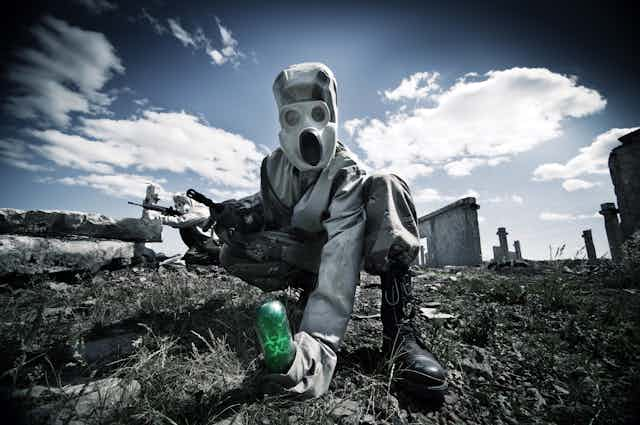Warning: this article is accompanied by an image that some readers might find distressing.
The United States has issued a stark warning that Russia is preparing to use biological and chemical weapons in Ukraine. The claim comes off the back of accusations by Russia that it is Ukraine who is willing to resort to chemical and biological warfare. A spokesperson for the Russian foreign ministry, Maria Zakharova, has alleged that the US is collaborating with Ukraine to develop these weapons of mass destruction.
White House press secretary, Jan Psaki, strenuously denies these claims. She has stated that Russia is the real threat. Psaki announced on Twitter that not only are Zakharova’s claims false, but that Russia is making them in order to justify its own employment of chemical and biological arms in the conflict.
Psaki warned: “Now that Russia has made these false claims, and China has seemingly endorsed this propaganda, we should all be on the lookout for Russia to possible use chemical or biological weapons in Ukraine.” Dismissing the charges against Ukraine, she continued: “It’s Russia that has long maintained a biological weapons program in violation of international law.”
Biological warfare
Psaki is right that Russia has an extensive and controversial biological warfare capacity. Biological weapons programmes tend be shrouded in the upmost secrecy and information on them is difficult to verify. Yet we know that the USSR developed a biological weapons programme since the 1920s. The programme was not halted when the country ratified the 1925 Geneva Protocol – which limits the use of biological and chemical armaments – although that agreement did technically allow the Soviets to own and develop these weapons.
The Soviet Union built up its biological weapons programme throughout the cold war and this was later expanded under the name Biopreparat. The programme continued even after 1972 when the USSR signed the Biological Weapons Convention (BWC). The agreement prevents a state from having and using biological arms.
Despite that commitment, the Soviet Union developed a wide range of biological weapons, including anthrax, plague, smallpox and tularemia (Rabbit disease). The programme also oversaw major advances in biotechnology, such as the development of antibiotic resistant agents. At its height, the programme employed around 60,000 people.
The USSR kept the programme secret and denied that it existed. But suspicions were raised in 1979 when anthrax was accidentally released from a secret military facility at Sverdlovsk. At least 64 people died in the incident.
Boris Yeltsin, Russia’s first president and successor to the Soviet leaders, finally admitted that the programme existed in 1992, causing an international scandal. Soviet defectors who worked on the programme, such as Ken Alibek(formerly Kanatjan Alibekov), have also confirmed that it had been developing these weapons on a considerable scale and that they could kill 100,000 people in a strike.
Today, Russia is bound by the BWC to disarm and remove all its biological weapons. It has also signed further agreements that would require it to get rid of its biological arsenal, such as a trilateral arrangement with the US and UK in 1992 – although this failed in 1996 when Russia refused to reveal the full details of its programme.
How far Russia has actually disarmed is unknown. Yet experts maintain that it still has a major programme So, while there is little evidence that Russia has ever actually used biological weapons in the past, we should assume that it has the capacity to do so.
Chemical agents
As for chemical warfare, Russia is known to have possessed the world’s largest chemical arms stockpile and owned approximately 40,000 metric tons of chemical agent that could be used in an attack. This arsenal included numerous types of chemical weapon including the nerve agent sarin as well as mustard gas and phosgene gas.
What the Russian chemical arsenal looks like now is the subject of controversy. Russia has signed the 1993 Chemical Weapons Convention that prohibits chemical weapons and officials claim that the country destroyed the last of its chemical stockpile in 2017.
Yet this claim that Russia has abandoned its chemical armaments is clearly false. Russia used Novichok nerve agent – a type of chemical weapon – in the attempted assassinations of Sergei Skripal in Salisbury in 2018 and Alexei Navalny in 2020, although Russia denies this. These incidents took place after Russia claimed to have eliminated its chemical arms. The attacks demonstrate that Russia has both the resources to carry out chemical warfare and the willingness to do so.

The concern that Vladimir Putin would use chemical weapons is serious. The Syrian president, Bashar al-Assad, used these armaments throughout the conflict in Syria to break down the rebel defences when conventional bombing was not enough - for example, at Douma near Damascus in 2018.
In an attempt to complete the invasion of Ukraine as quickly as possible, Russia has already escalated to more destructive armaments to achieve this, such as the use of vacuum bombs. If Putin wants to get the job done fast then chemical weapons may look like an attractive option.
Russia can use biological and chemical arms. If it does then this will put massive pressure on the rest of the world to act. The US carried out airstrikes against Syria when Assad employed chemical weapons. This raises the critical question: will the west be prepared to do the same if Putin also crosses this line?

